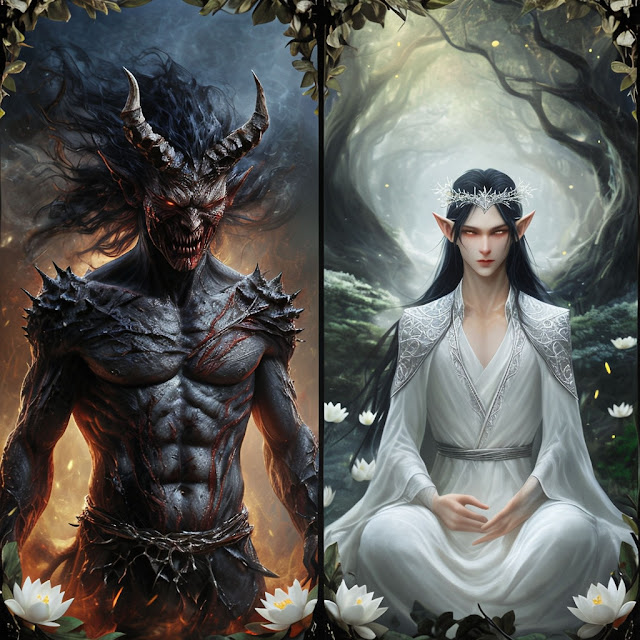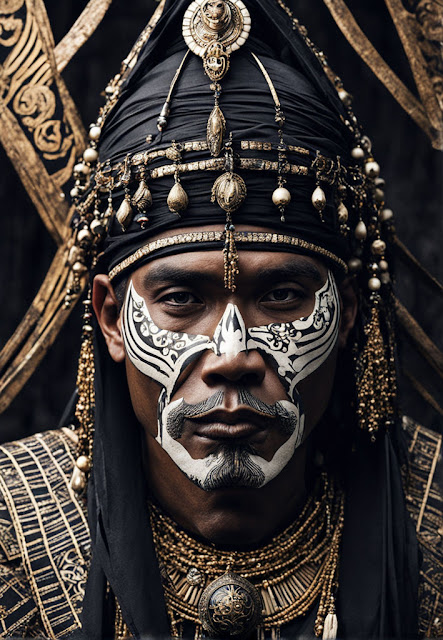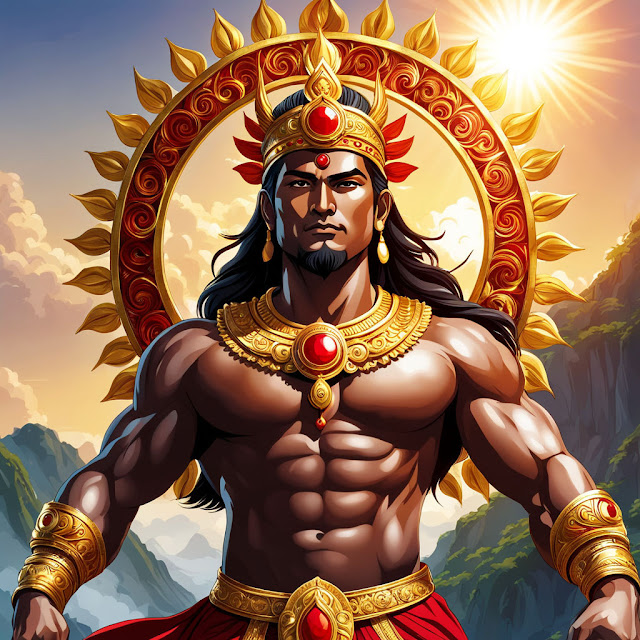In Philippine mythology, the terms Kaliwa and Kanan are often used as euphemisms to describe the moral alignment of mythical creatures and practitioners of magic. These terms categorize beings and magic users into two broad groups: Kaliwa, sometimes called Itim representing those associated with evil or harmful magic, and Kanan, sometimes called Puti referring to those who embody goodness and benevolence. This duality highlights the ongoing struggle between good and evil forces in Filipino folklore, a tradition still alive and vibrant today.
The Kaliwa: Evil Beings and Dark Magic Users
The term Kaliwa, in mythology meaning "left," is used to refer to malevolent beings and practitioners of dark magic. It encompasses a wide variety of fearsome creatures, spirits, and sorcerers whose powers are often employed to harm or deceive humans. Some of the most infamous beings in the Kaliwa group include:
1. Aswang:
 |
| Aswang |
The Aswang is the most feared creature in Philippine folklore. It is a term used for various supernatural beings known for their malicious intent, shape-shifting abilities, and predatory nature. They often prey on the vulnerable, such as pregnant women and children. Variants of Aswang include:
- Manananggal: A winged creature that can sever its upper body to fly in search of human prey, particularly pregnant women.
- Tiktik: A bird-like creature that assists the Aswang in locating its victims by producing eerie sounds.
- Sigbin: A creature that resembles a cross between a dog and a goat, said to walk backward and feed on the blood of its victims.
- Gabunan
- Bangkilan
- Bonggo
- Wak-wak
- Ekek
- Bal-Bal
- Ebwa
- Abwak
- Asbo
- Awok
- Wak-wak
- Uwak-uwak
- Kiwig
- Mangalo
- Yawa
- Iwig
- Kiwig
2. Dalaketnon:
 |
| Dalaketnon |
.jpeg) |
| Dalaketnon |
The Dalaketnon are coined as evil Engkantos (enchanted beings) who inhabit large trees, especially balete or dalakit trees. They are often depicted as handsome beautiful yet dangerous creatures who use their charm to deceive and abduct humans, dragging them into their mystical world where time passes differently. Humans taken by Dalaketnon are often enslaved or never seen again.
3. Manbabarang:
A Manbabarang is a sorcerer who practices a form of dark magic involving the use of insects or other creatures to bring sickness and death to their enemies. They use malevolent spirits and hexes to possess or curse their victims, causing immense suffering.
4. Manlalason:
The Manlalason specializes in poison magic. They use toxic substances and enchantments to harm or kill others. Their methods involve slow-acting poisons that bring about sickness, suffering, and death.
5. Mangkukulam:
A Mangkukulam is a witch or sorcerer skilled in casting curses and hexes. They are feared for their ability to cause illness or misfortune through ritualistic practices, using wax dolls or incantations to harm their victims.
6. Mansisilat:
The Mansisilat is a master of deception and illusions. They use their magic to manipulate the minds of their targets, creating confusion, fear, and destruction. They are known to use their powers to tear apart relationships, families, and communities.
These beings and practitioners of dark magic often strike fear into the hearts of the people, with many stories serving as warnings to avoid disrespecting nature, disobeying elders, or wandering alone at night.
7. Tamawo:
The Tamawo are a race of albino-like enchanted beings in Philippine mythology, often linked to the darker side of the supernatural. They are said to have fair or pale skin the Tamawo are often depicted as dangerous and deceptive, using their allure to lure humans, especially those who are greedy or disrespectful towards nature, into their domain. They are notorious for abducting humans, particularly women and children, taking them into their otherworldly homes, where time flows differently. In some stories, those who are taken by the Tamawo rarely return, and if they do, they are forever changed
8. Pangantohan (Dark Soothsayers):
The Pangantohan are a form of soothsayers or fortune tellers in Philippine mythology, but unlike benign seers, they are often associated with the Kaliwa, as they use their powers for selfish or harmful purposes. These practitioners have the ability to foresee the future, manipulate destiny, or divine hidden knowledge, but they are feared because their insights frequently lead to misfortune, curses, or other ill events.
Often sought by those who want to harm others or gain an unfair advantage, the Pangantohan are masters of dark omens, foretelling disaster or death and offering ways to cause or avoid such fates—for a price.
9. Engkantong Itim:
Itim na Engkanto - Mga engkanto na nagpapakita bilang mga anino o mga itim na nilalang. Mga maligno na mapanakit at mapaminsala. Sila ay tinatawag na Engkanto Negro o mga itim na elemento. Nagpapkita sa mga tao at nanahan Ang mga engkantong itim sa malalaking bahay. Mapanakit at nakakatakot. Ang mga itim na Espiritu ay minsan sumasapi sa mga taong kanilang napupusuan. Ang mga tunay nilang katawan ay nasa Mundo ng mga engkanto tanging mga anino lamang nila ang nanahan sa mundo ng mga tao.
The Kanan: Benevolent Beings and Healers
In contrast, the Kanan, meaning "right," refers to benevolent creatures and practitioners of good magic. They embody the protective, healing, and nurturing aspects of Filipino mythology. These beings are often invoked for blessings, protection, and healing, standing as defenders of the people against the forces of darkness.
 |
| Diwata surrounded by Lambana |
 |
| Diwata and Lambana |
1. Diwata:
 |
| Diwata |
The Diwata are powerful nature spirits, god and goddesses. They are often likened to dryads or high fairies, governing forests, rivers, and mountains. Diwata can be both kind and wrathful, depending on how humans treat their domain. They protect the natural world and are known for their wisdom, beauty, and magical abilities. They often aid those who show respect for the environment and seek their blessings.
- Lambana: A smaller variant of the Diwata, the Lambana are small fairies that serve as protectors of nature. They are often seen flitting around flowers and trees, granting good fortune and blessings to those they favor.
 |
| Lambana |
2. Mangagamot:
The Mangagamot is a traditional healer who uses a combination of herbs, prayers, and rituals to heal ailments. Their knowledge of medicinal plants and spiritual healing practices makes them invaluable members of their communities. Unlike their dark counterparts, the Mangagamot's powers are used for the well-being of others, curing illnesses and expelling evil spirits.
3. Albularyo:
The Albularyo is another form of folk healer who blends herbal medicine and magic. They are often the first people approached for healing ailments, spiritual cleansing, or protection from evil spirits. Albularyos are highly respected in Filipino communities for their ability to treat physical and supernatural afflictions.
4. Manunugis:
The Manunugis is a hunter of evil spirits and dark creatures. They specialize in tracking down Aswangs, malevolent Engkantos, and other Kaliwa beings. Using special incantations, blessed weapons, and protective talismans, the Manunugis protect their communities from harm by banishing or destroying the evil forces they encounter.
5. Mahomanay:
The Mahomanay are nature spirits portrayed as good Engkanto known for their elf-like appearance and their deep connection to the natural world. These male spirits have pale skin and long black hair, and they are often seen wearing simple, flowing garments that blend seamlessly with the forests and natural environments they protect. Like the Diwata, the Mahomanay are guardians of nature, particularly concerned with the well-being of animals and the preservation of forests.
.jpeg) |
| Mahomanay |
The Mahomanay are believed to be kind-hearted and benevolent, often coming to the aid of animals in distress or protecting ecosystems from harm caused by humans. They are revered as keepers of balance in nature, and those who show respect for the environment might be blessed with their favor. However, those who destroy nature or harm animals may find themselves on the wrong side of the Mahomanay’s protective powers.
6. Tahamaling
.jpeg) |
| Tahamaling |
The Tahamaling are female Engkanto known for their fierceness and striking red complexion. Guardian of forest and its animals. The Tahamaling is the female counterpart of the gentle Mahomanay. But more aggressive in protecting her domain. Some stories suggest she grants people with good intentions a Mutya imbued with magical powers connected to animals.
.jpeg) |
| Tahamaling |
7. Abyan
8. Babaylan (Spiritual Leaders and Healers):
The Babaylan are highly revered spiritual leaders, shamans, and healers in Philippine culture, aligned with the Kanan because of their profound connection to the divine and their role in maintaining the balance between the physical and spiritual worlds. These powerful women (and in rare cases, men) serve as intermediaries between humans and the spirits, performing vital roles such as healing, conducting rituals, and communicating with ancestral spirits, gods, and nature spirits.
The Babaylan have the ability to invoke the Diwata, call upon protective spirits, and channel the energies of nature to heal the sick, bless crops, and protect their communities from harm. They also play a crucial role in cleansing and purifying spaces, driving away malevolent spirits from the Kaliwa such as Aswangs and Tamawo, and maintaining the spiritual equilibrium of their people.
The Babaylan's rituals often involve prayers, dance, and sacrifices to appease the gods and ensure the welfare of their communities. Their wisdom, handed down through generations, reflects a deep understanding of nature, medicine, and the cosmos, further cementing their position as figures of light and good within the Kanan. Today, the legacy of the Babaylan continues to thrive, as they are recognized as custodians of traditional Filipino spirituality and protectors of cultural identity.
9. Antingero (Charm Makers and Keepers of Mystical Talismans):
The Antingero are individuals who create and wield anting-anting, or mystical amulets, believed to bring protection, strength, and good fortune. They align with the Kanan because they use their knowledge of charms and talismans for benevolent purposes, helping individuals defend themselves against the forces of the Kaliwa. Anting-anting are traditionally imbued with sacred powers, passed down through rituals, prayers, and chants, invoking blessings from the Diwata, Babaylan, or other protective spirits.
These amulets can be used to ward off evil entities such as the Aswang, Tamawo, and other malevolent forces. The Antingero also assist in giving protection during times of battle or danger, enhancing their wearers’ physical or spiritual abilities. Anting-anting can come in the form of medallions, written prayers, or even herbs and stones enchanted with powerful prayers and rituals.
The Antingero, through their work, preserves ancient knowledge of Filipino mysticism and spirituality. They act as defenders against the dark forces of the Kaliwa, ensuring their communities remain safe and spiritually fortified.
These Kanan creatures and practitioners work in harmony with nature, protecting humans from illness, misfortune, and malevolent spirits. Their roles as healers, protectors, and guides offer a vital counterbalance to the threats posed by the dark forces of the Kaliwa.
Kaliwa and Kanan in Modern Philippine Culture
Philippine mythology, despite centuries of colonization and the spread of Christianity, continues to thrive in modern times, especially in rural areas where traditional beliefs are still widely practiced. The Kaliwa and Kanan dichotomy remains a significant part of Filipino folklore, influencing how people view the moral spectrum of supernatural forces.
Even today, stories of Aswangs, Diwatas, Mangkukulams, and Albularyos persist, passed down through oral traditions, popular media, and even urban legends. Many Filipinos still consult Albularyos and Mangagamots for traditional healing, while others hold festivals and rituals to honor the Diwata and seek protection from the Kaliwa.
The Kaliwa and Kanan duality is a reflection of the Filipino understanding of balance—between good and evil, darkness and light. It speaks to a worldview where supernatural forces are ever-present, and the choices individuals make, whether in magic or morality, ripple through the natural and spiritual worlds.



.jpeg)









.jpeg)


.jpeg)
.jpeg)




.jpeg)
.jpeg)
.jpeg)


.jpeg)

%20(11).jpeg)


.jpeg)
.jpeg)
.jpeg)
.jpeg)
.jpeg)
.jpeg)




.jpeg)



.jpeg)
.jpeg)











.jpeg)






